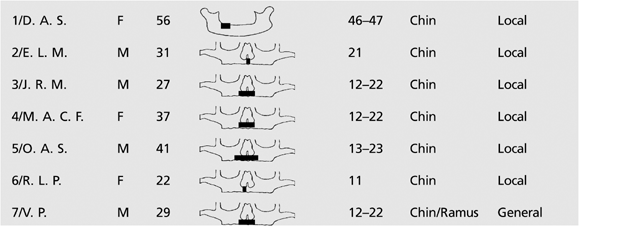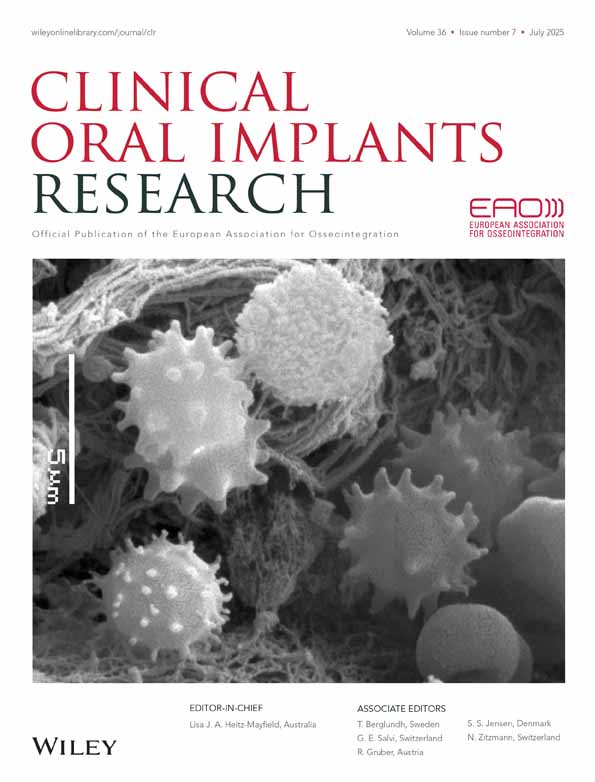Tissue response to poly-L-lactide acid-polyglycolic acid absorbable screws in autogenous bone grafts: a histologic morphological analysis
Die Gewebeantwort auf resorbierbare Schrauben aus PLA–PGA in autologen Knochentransplantaten. Eine histologische morphologische Analyse
Abstract
enObjectives: To evaluate the local bone condition of autogenous chin grafts in contact with resorbable polymers fixation devices.
Material and methods: Seven patients presenting severe maxillary and mandibular atrophy underwent alveolar ridge reconstruction with autogenous chin grafts fixed with conventional metallic screws, who received poly l-lactide acid–polyglycolic acid and titanium test screws for histological evaluation after 4 months of implantation.
Results: Viable bone tissue could be seen in the specimens related to titanium test screws, with no signs of bone resorption or inflammation. A thick layer of fibrous connective tissue was observed between the resorbable test screws and bone tissue, which presented a few areas of resorption.
Conclusion: There are no contraindications of both materials for use as fixation devices in autogenous bone grafts. However, care must be taken when using absorbable screws in a period of 4 months, which can interfere with the sequence of the treatment with endosseous dental implants.
Résumé
frLe but de cette étude a été d'évaluer la condition osseuse locale de greffons autogènes du menton en contact avec des systèmes de fixation polymère résorbable. Sept patients présentant une atrophie mandibulaire ou maxillaire sévère ont subi une reconstruction du rebord alvéolaire avec des greffons autogènes du menton fixés avec des vis métalliques conventionnelles qui avaient reçu du PLA-PGA et des vis tests en titane pour l'évaluation histologique après quatre mois d'implantation. Du tissu osseux viable pouvait être aperçu dans les spécimens en relation avec les vis tests en titane sans signe de résorption osseuse ni d'inflammation. Une épaisse couche de tissu conjonctif fibreux était observée entre les vis tests résorbables et le tissu osseux presentant quelques aires de résorption. Il n'y avait donc aucune contre-indication des deux matériels pour leur utilisation comme modèle de fixation dans les greffons osseux autogènes. Cependant, il faut rester attentif lorsque les vis résorbables sont utilisées dans la période de quatre mois pouvant interférer dans la séquence du traitement avec des implants dentaires endoosseux.
Zusammenfassung
deZiele: Den lokalen Zustand von autologen Knochentransplantaten vom Kinn, welche in Kontakt mit resorbierbaren Fixationselementen aus Polymeren stehen, zu untersuchen.
Material und Methoden: Sieben Patienten mit ausgeprägter Resorption des Ober- und Unterkiefers unterzogen sich einer Rekonstruktion des Alveolarkammes mit Transplantaten vom Kinn, welche mit konventionellen Metallschrauben befestigt wurden. Zusätzlich wurden Testschrauben aus PGA–PLA und Titan eingesetzt. Vier Monate nach Implantation der Testschrauben erfolgte die histologische Auswertung.
Resultate: In den Präparaten konnte in Zusammenhang mit den Testschrauben aus Titan vitaler Knochen mit keinerlei Anzeichen von Resorption und Entzündung gesehen werden. Zwischen den resorbierbaren Testschrauben und dem Knochengewebe konnte eine dicke Schicht aus fibrösem Bindegewebe beobachtet werden. Es waren einige wenige Areale mit Resorptionen zu erkennen.
Schlussfolgerung: Für beide Materialien bestehen keine Kontraindikationen, wenn sie zur Fixierung von autologen Knochentransplantaten verwendet werden. Mit den resorbierbaren Schrauben ist jedoch Vorsicht geboten, da sie in einer Zeitspanne von 4 Monaten den Ablauf der Behandlung mit enossalen Implantaten beeinträchtigen könnten.
Resumen
esObjetivo: Evaluar las condiciones del hueso local de injertos autógenos del mentón en contacto con dispositivos de fijación de polímeros reabsorbibles.
Material y métodos: Siete pacientes con atrofia maxilar y mandibular severas fueron sometidos a reconstrucción de la cresta alveolar injertos autógenos mentonianos fijados con tornillos metálicos convencionales, que recibieron tornillos de prueba de PLA–PGA y de titanio para evaluación histológica tras cuatro meses de la implantación.
Resultados: Se pudo observar tejido óseo viable en los especímenes relacionados con los tornillos de titanio de prueba, sin signos de reabsorción ósea o inflamación. Se observó una capa gruesa de tejido conectivo fibroso entre los tornillos reabsorbibles de prueba y el tejido óseo, que presentó algunas áreas de reabsorción.
Conclusión: No existen contraindicaciones para que ambos materiales puedan ser usados como material de fijación en injertos de hueso autógeno. De todos modos, deben tomarse precauciones cuando se usan tornillos reabsorbibles en el periodo de cuatro meses que puedan interferir con la secuencia del tratamiento con implantes dentales endoóseos.





